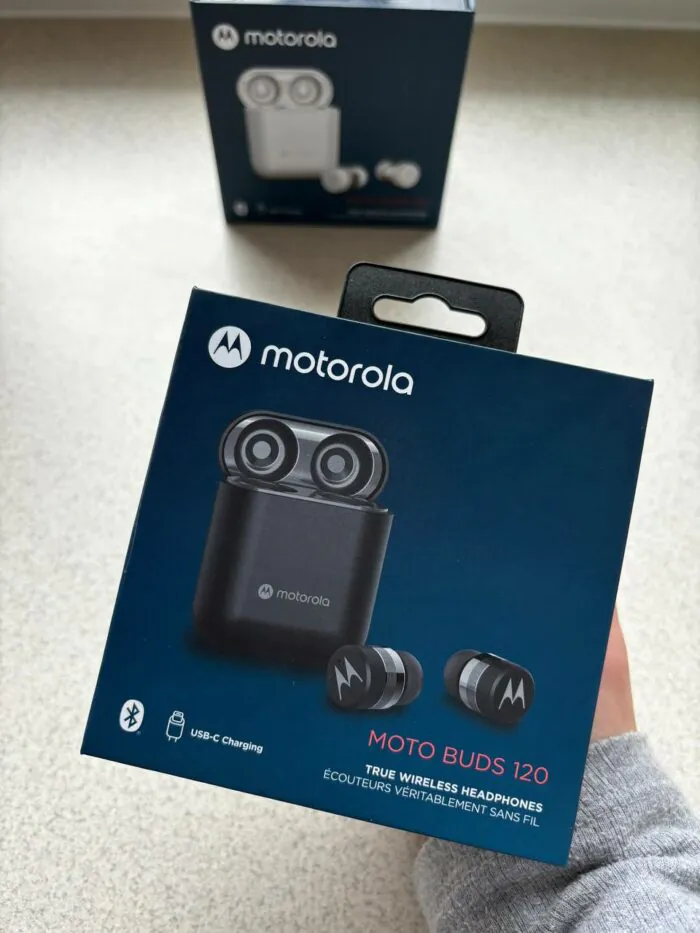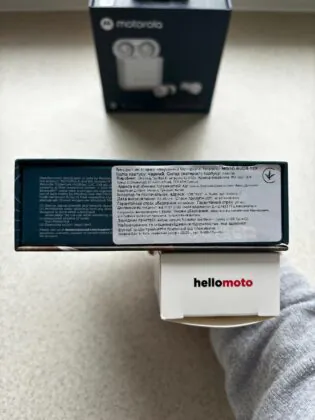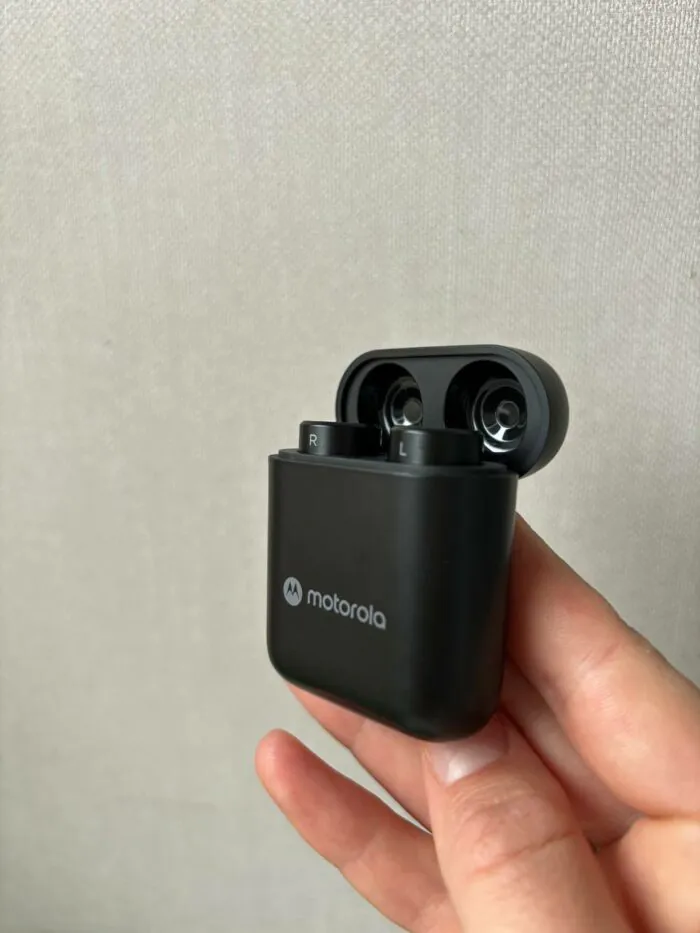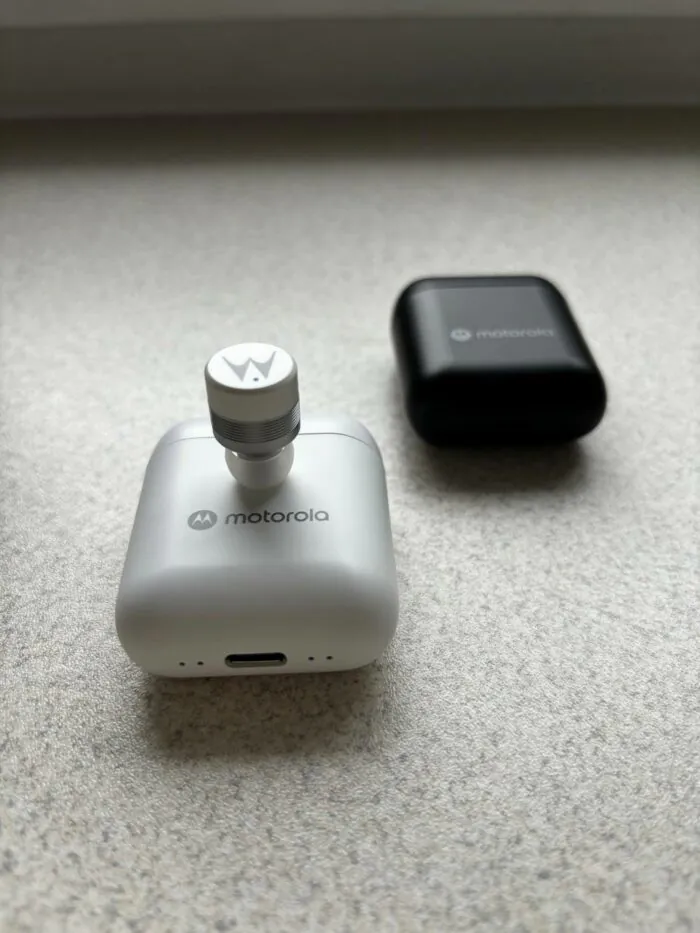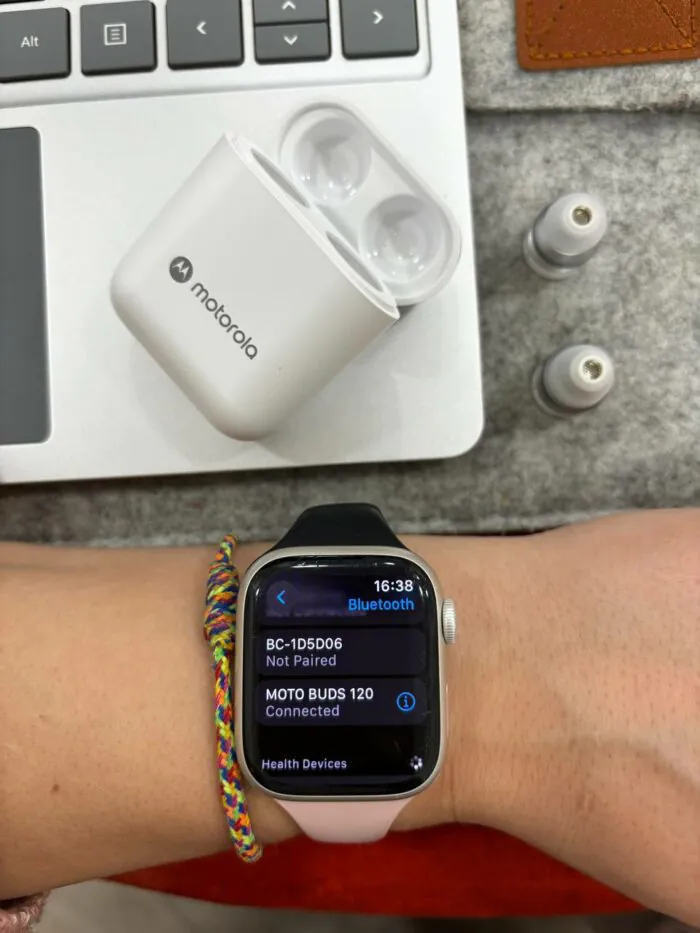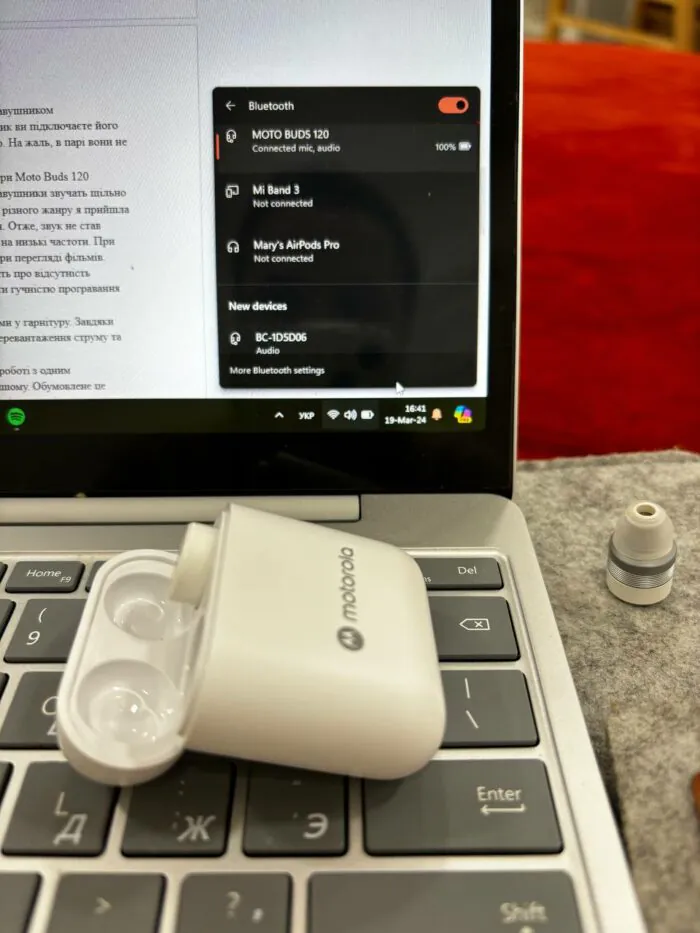© ROOT-NATION.com - Use of content is permitted with a backlink.
Motorola likes to delight its fans with interesting devices. One such device that landed in my hands for review is the Moto Buds 120 earbuds. The manufacturer promises a lot of interesting features, including “premium sound,” enhanced water resistance, and high autonomy. So let’s not waste any time and dive straight into testing.

Read also: Motorola Moto Buds 105 review: decent basic TWS headphones
Moto Buds 120 specifications
The first thing that catches your eye is the improved sound without transmission losses from one earbud to the other, the ability to use one earbud and not worry about signal loss or interruption. Also, Motorola managed to equip each earbud with a sensor for control, even despite their size. Below we’ll talk about each aspect in more detail, but for now, let’s take a look at the general technical specifications:
- Headphone Type: TWS, in-ear
- Earbud Material: Silicone
- Frequency Response Range: 20-20000 Hz
- Sensitivity: 93 dB/1 mW
- Impedance: 15 Ohms
- Connectivity Type: Bluetooth 5.0
- Operating Range: 30 meters
- Connector Type: USB Type-C
- Media Player Function: No
- Sensitivity: 99 dB
- Water Resistance: IPX5
- Active Noise Cancellation: Without active noise cancellation
- Number of microphones: 2
- Charging time: 2 hours
- Working time with a charging case: 17 hours
- Headphone time: up to 6 hours
- Battery capacity: 300 mAh
- Multipoint support: yes
- Color: Black and White
Read also: Review of TOZO HT2 headphones: quality sound at a budget price
Positioning and price
The Moto Buds 120 combines quality with an intriguing design. From the moment you lay eyes on them, these earbuds catch your attention with their exterior appearance, and as you delve into exploring their capabilities, the interest only intensifies. The Buds 120 are lightweight and feature interesting solutions for typical tasks such as charging, placement in the case, and control. The price of the earbuds ranges from $45 to $49.
What’s in the package
Let’s move on to the review of the Moto Buds 120 packaging. The earbuds are packaged in a sturdy cardboard box that opens like a book and closes with a magnet.
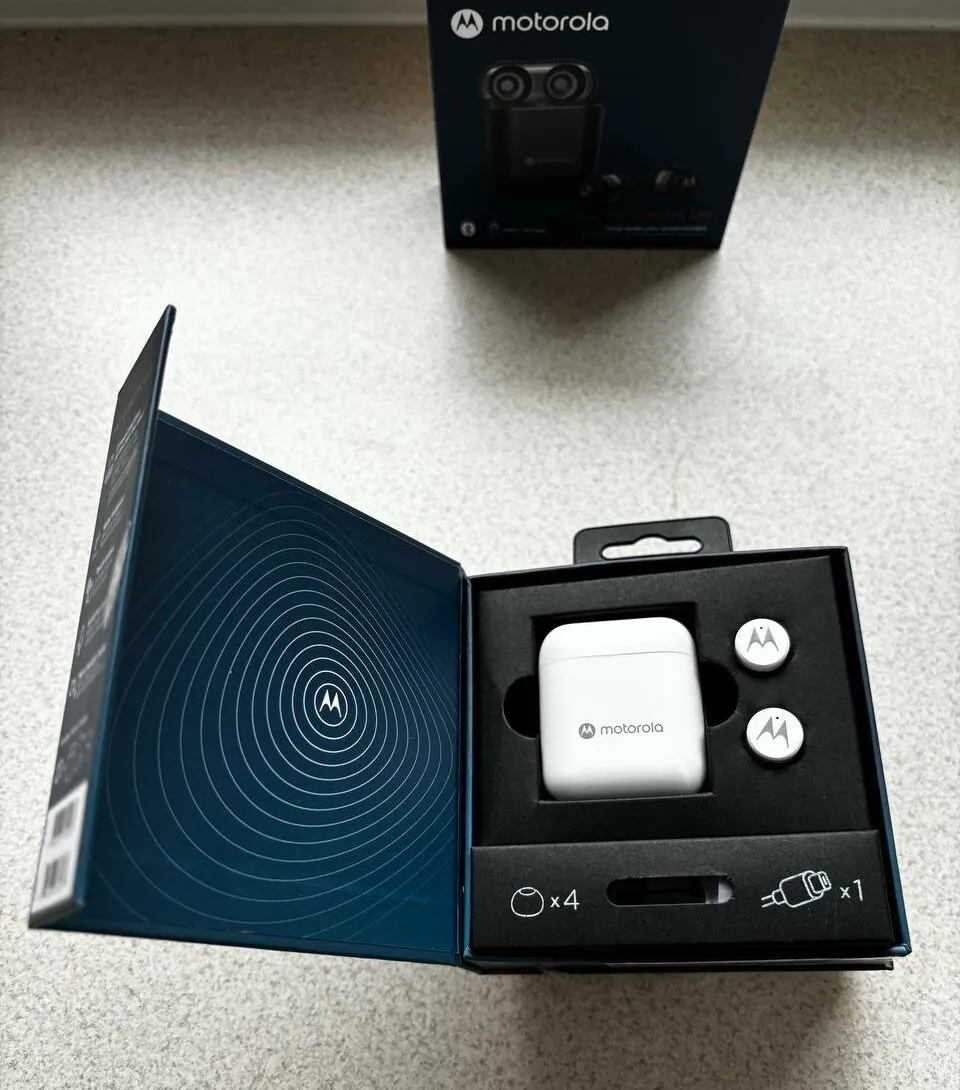 On the front side of the box, there is an image of the earbuds, the model, and the brand logo. The back side succinctly describes the design concept of the earbuds, and there is an attached box containing an additional accessory – a case cover for the charging case. The color of the case cover matches the color of the earbuds’ case.
On the front side of the box, there is an image of the earbuds, the model, and the brand logo. The back side succinctly describes the design concept of the earbuds, and there is an attached box containing an additional accessory – a case cover for the charging case. The color of the case cover matches the color of the earbuds’ case.
The most informative sides of the box are the lateral sides. Here, we can find information about the manufacturer, the brand logo, brief technical specifications, and a short comment regarding the Moto Buds 120 model from the manufacturer.
Upon opening the box, we immediately gain access to the charging case, earbuds, a USB Type-C cable, and an additional three pairs of interchangeable ear tips (one pair is already attached to the earbuds). The ear tips are made of semi-transparent matte silicone. The cable and extra ear tips are packaged separately in a cardboard insert, and the earbuds are also placed separately from the case in a niche within the box. Additionally, the package includes technical documentation and a warranty card.
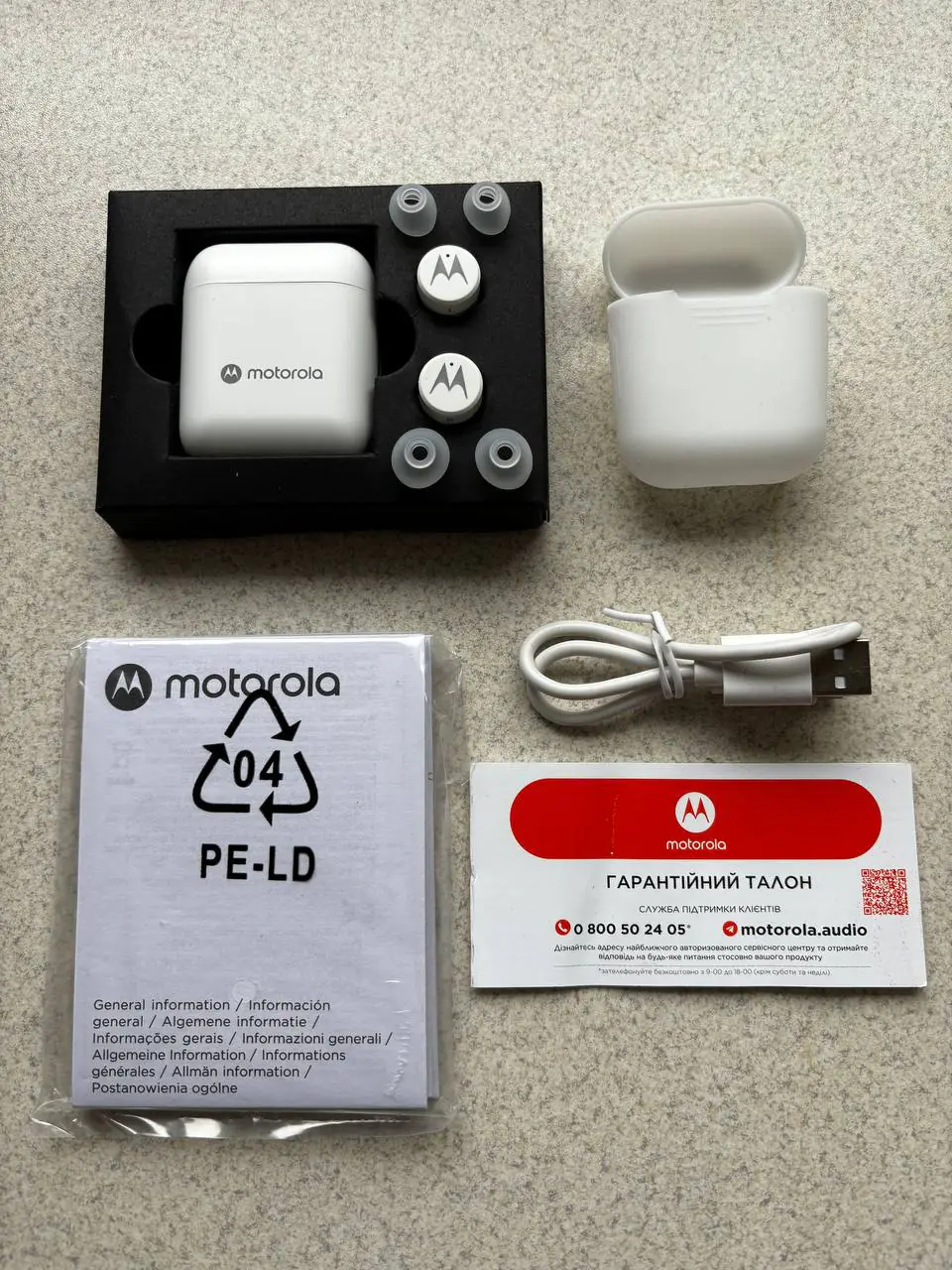
Read also: Motorola Moto G34 5G Review: Successful Budget Phone
Design, materials, assembly of Moto Buds 120
The earbuds are available in two classic colors: black and white. The case is rectangular with rounded edges, of standard size.
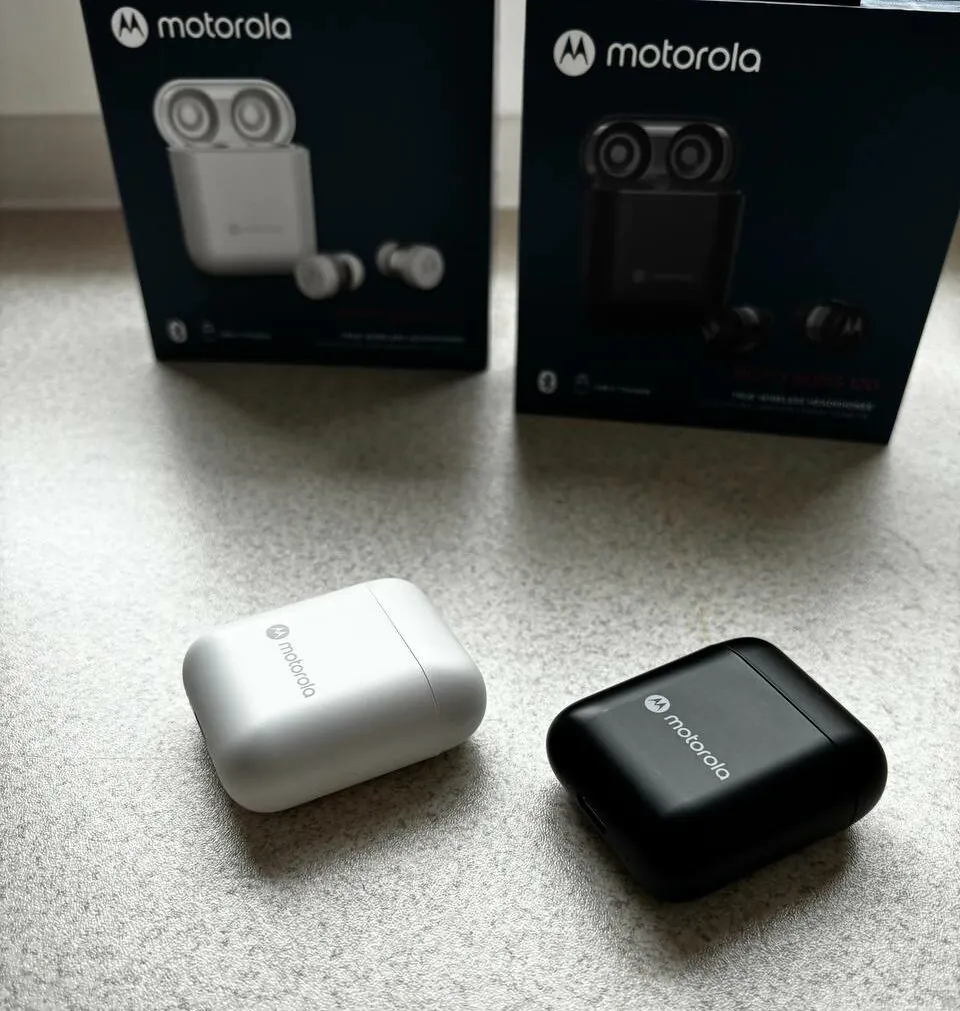
On the front side of the case, the brand name is centered. On the back, the specifications of the Moto Buds 120 and the manufacturing country are indicated.
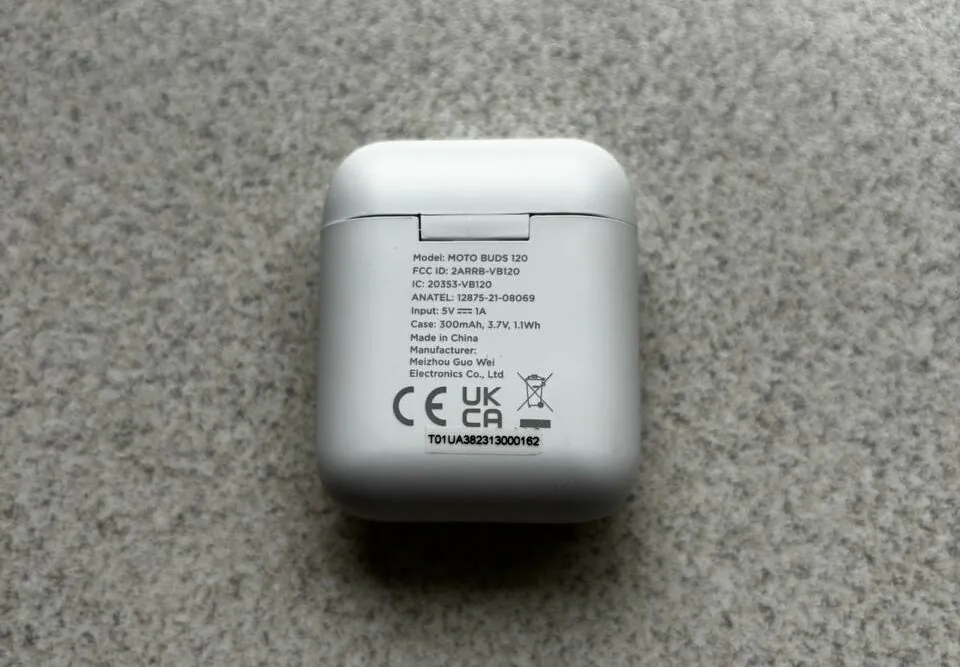
The earbuds themselves are cylindrical in shape. In the center of their back portion, the Motorola logo is placed, and above it, there is a microphone opening where the indicator is also located. The Buds 120 are not only miniature but also quite lightweight, with each weighing only 4 grams.
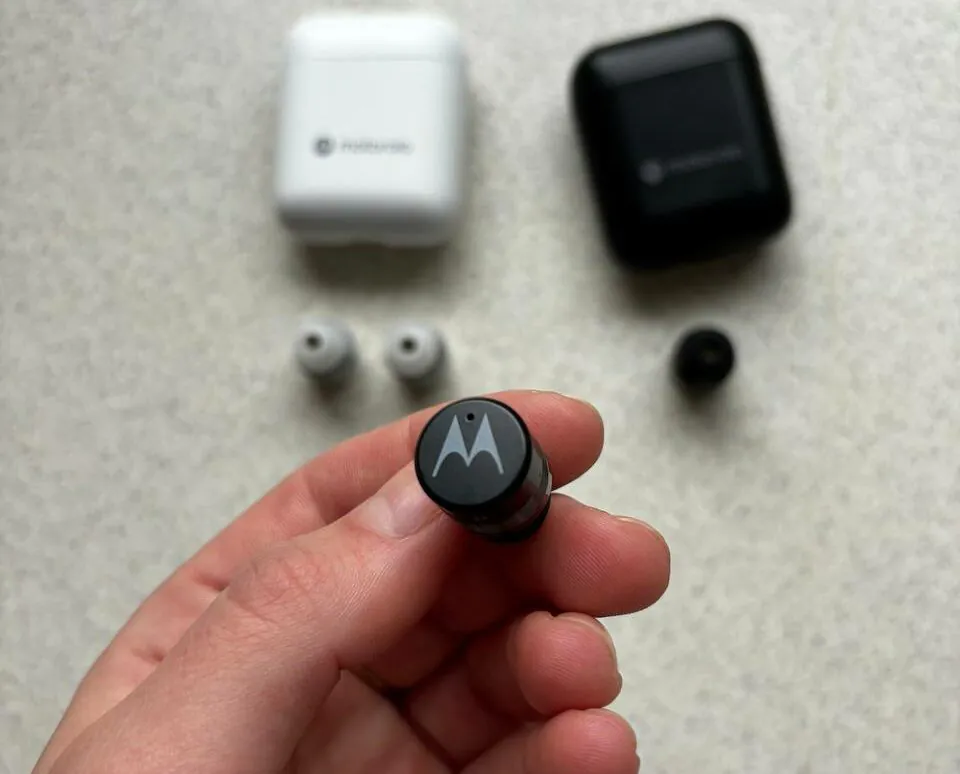
Read also: Motorola Razr 40 Ultra Review: Trend-setting Foldable Smartphone
Design and arrangement of elements
The cover of the Moto Buds 120 case opens quite widely (at a 90-degree angle). When opened, it securely locks in place, even if the case is shaken – it will not change its position.
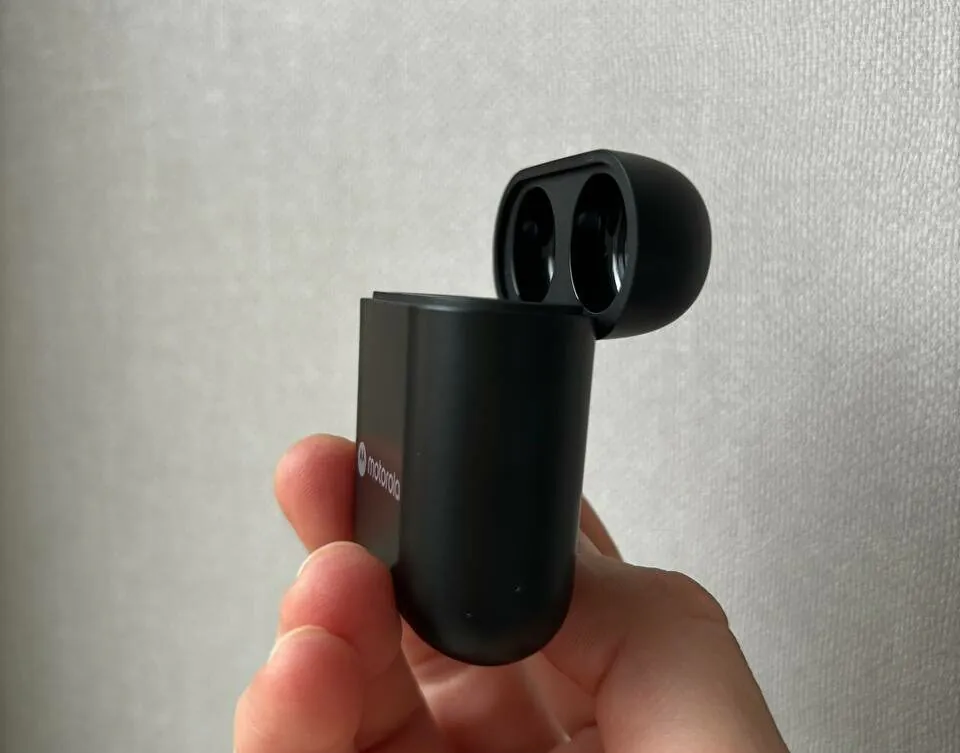
At the bottom, there’s a Type-C port. On both sides of it, there are two LED indicators indicating the battery level. Opening and closing the case will also reflect the battery level.
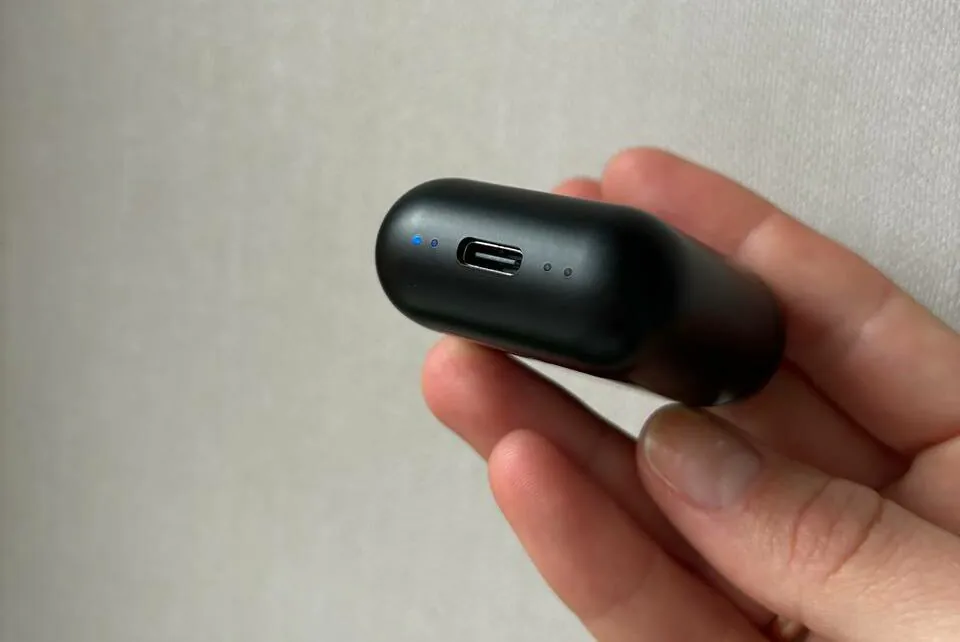 The unusual charging solution for the earbuds in the case catches the eye. In addition to the usual small contacts at the bottom of the case, Moto Buds 120 has installed a ring, just like on the earbuds themselves. Interestingly, I didn’t immediately recognize this ring on the earbuds, as it looks like a design element.
The unusual charging solution for the earbuds in the case catches the eye. In addition to the usual small contacts at the bottom of the case, Moto Buds 120 has installed a ring, just like on the earbuds themselves. Interestingly, I didn’t immediately recognize this ring on the earbuds, as it looks like a design element.
The second contact is placed conventionally at the bottom of the recess, and on the earbuds themselves, the charging contact is a metal mesh covering the sound channel.
The magnetic connection occurs instantly and securely. The earbuds won’t fall out even when the case is open and turned upside down.
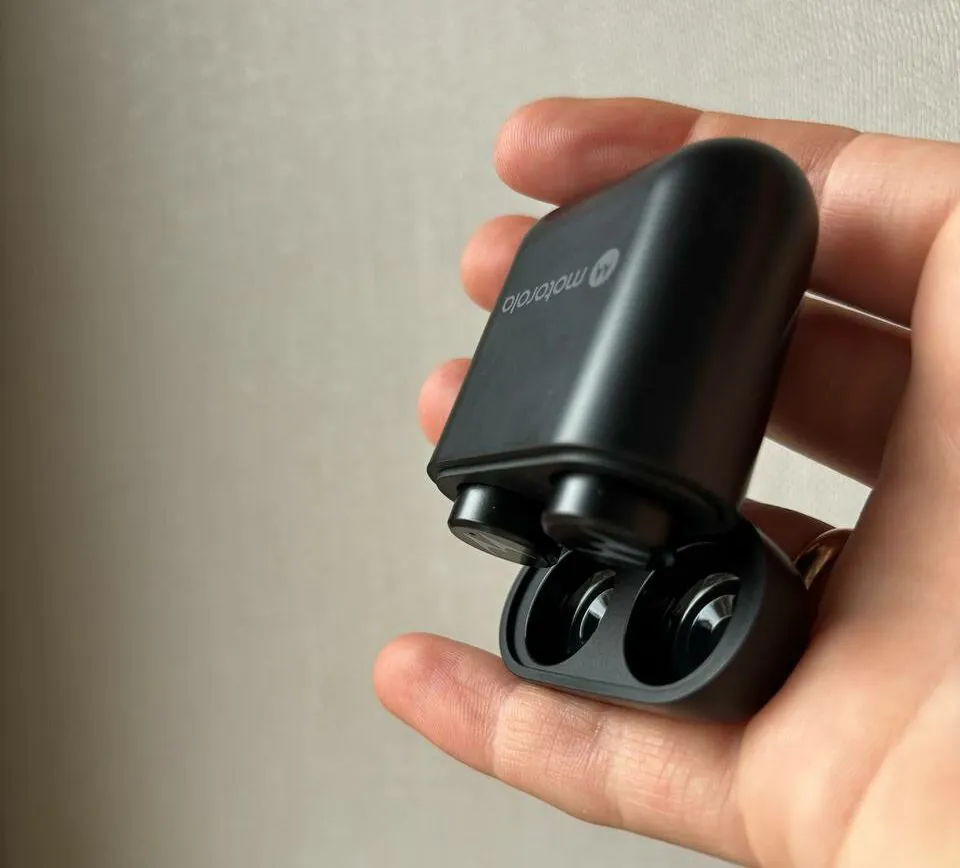
On the outer side of the earbuds, there is a control area and a microphone, which also serves as an indicator of the device’s status. Each earbud has an indication on the side to denote whether it is the right or left one.
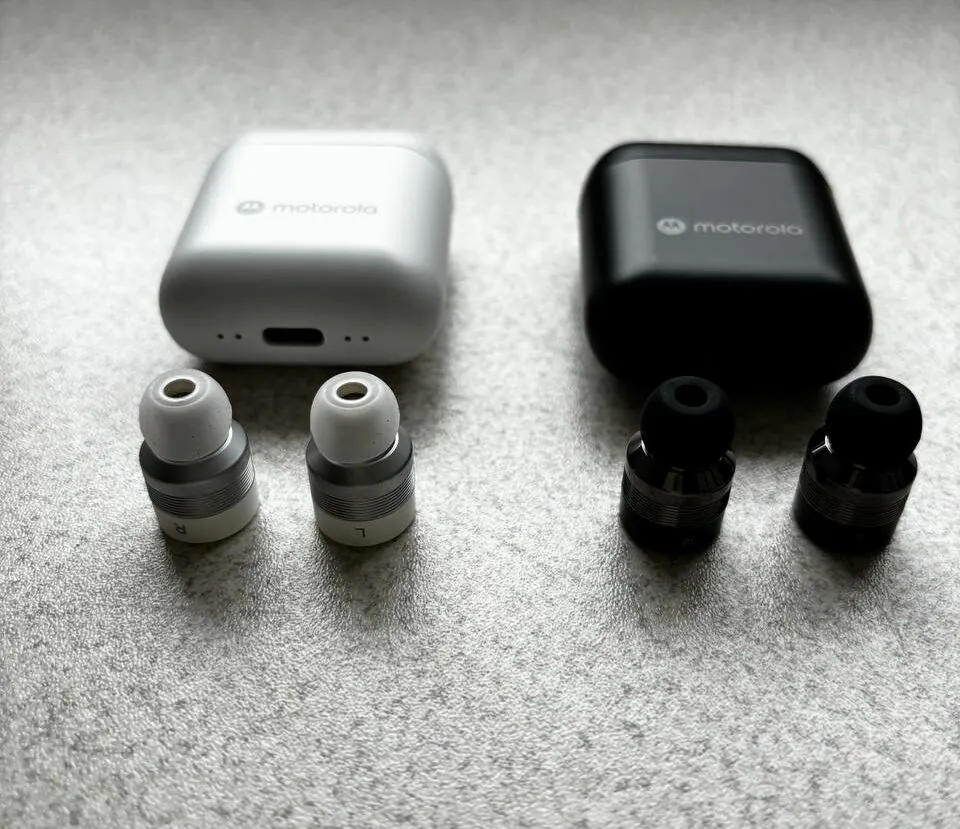
Motorola also claims that the earbuds are protected against overheating, over-discharge, over-current overload, and short circuits.
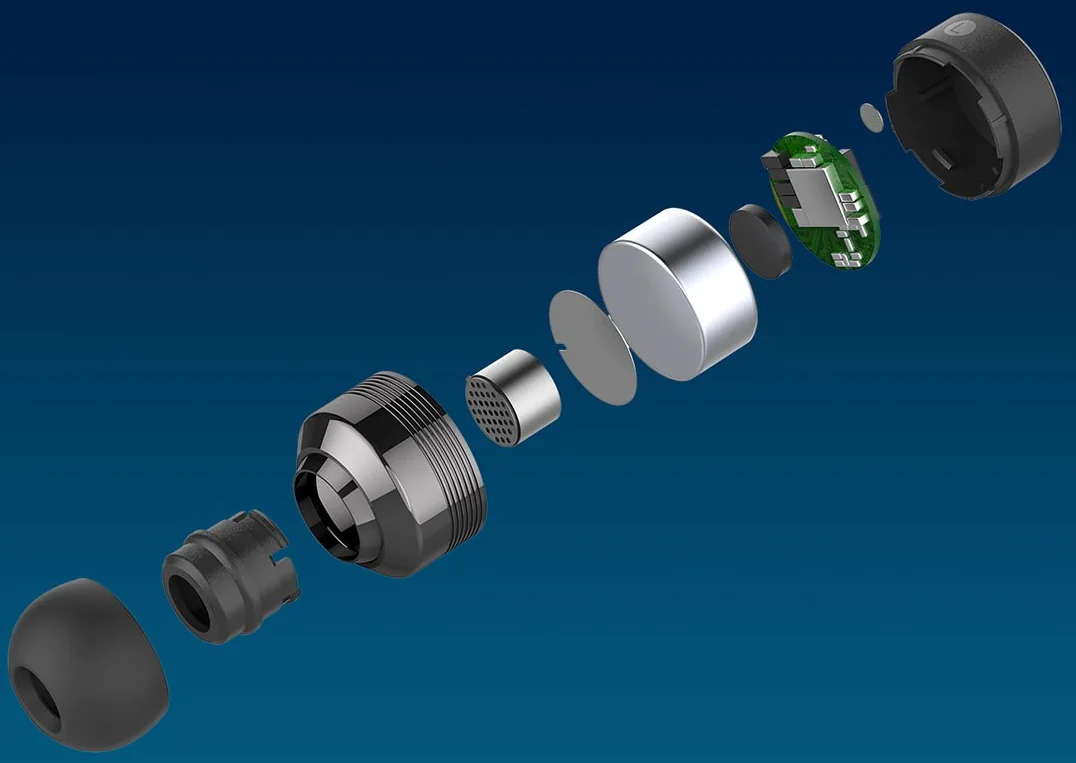
Comfort of use and control
At first, let me talk a bit about the case itself. I noticed that it opens tightly. I don’t see this as a problem and I assume that this aspect may improve with use. However, if this was intentional by the manufacturer, then it might be challenging to open it with one hand, especially while wearing gloves. Also, I found it easy to take out the earbuds, but my partner with larger fingers struggled a bit. Additionally, I noticed that it’s easier to maintain the white version as it collects less dust and fingerprints.

One point I want to highlight separately is that in the case, there’s a contact at the bottom of the groove that connects to the earbud. Cleaning it if needed can be quite inconvenient, so it’s better to handle it with care.
As for the Moto Buds 120 themselves, they are comfortable to use, lightweight, and fit snugly in the ears. Visually, the earbuds are barely noticeable. The medium-sized ear tips will likely suit most users, but there are three options to choose from.
Control is carried out using an intelligent touch button located on the outer part of the earbud. This button allows you to switch tracks, answer calls, and activate the voice assistant. Adding the voice assistant function, which can be configured for control instead of the touch button, is reasonable. Control gestures are standard and quite intuitive:
- One touch – pause
- Two touches – previous track
- Three touches – next track
- Pressing and holding the control area for a few seconds – activate the voice assistant / reject the call.
The sensor is responsive, and I haven’t experienced any false triggers. Unfortunately, there are no options to adjust the volume on the control area. However, let’s not forget that this is not a flagship device.
It’s nice to have IPX5 protection against water and dust. So heat, rain and sweat do not limit the capabilities of Moto Buds 120. Due to its design, the headphones are well insulated.

Read also: HUAWEI FreeBuds Pro 3 flagship headphones review
Moto Buds 120 sound and connectivity
The connection to the smartphone is established via Bluetooth 5.0. I was able to connect quickly to both iPhone and Android devices.
 Additionally, there is the option to connect to a smartwatch and computer. To pair with a device, you need to take the earbuds out of the case and start searching for the device in the Bluetooth menu.
Additionally, there is the option to connect to a smartwatch and computer. To pair with a device, you need to take the earbuds out of the case and start searching for the device in the Bluetooth menu.
The supported codecs are standard – AAC and SBC. Moto Buds 120 feature 6mm drivers, providing clear sound. The earbuds deliver a rich and energetic sound with emphasis on the bass frequencies. After listening to music of various genres, I concluded that it sounds consistently high-quality without distortion. Both high and low frequencies sound great. When watching videos on YouTube, there are no audio delays, and the same applies to movies. There is no specific gaming mode, so there might be a slight audio delay in games in theory.
The Moto Buds 120 also performed excellently when using a single earbud, with no loss of sound when switching between them. This is attributed to the use of microphones in both earbuds. I have personal experience where this feature comes in handy, such as during supermarket shopping or navigating busy streets, moments when you need to be more aware of your surroundings.
Read also: Motorola Edge 40 Neo review: sophistication all round
Microphones and headset function
Considering that the microphones in the Moto Buds 120 are located in the ears due to the design, I was particularly interested in testing their performance as a headset. Incoming calls are notified by the voice assistant. I was pleasantly surprised by the sound quality outdoors, even in windy conditions near the road. Although there was a slight echo and noise cancellation artifact, I could hear the caller clearly, and they could hear me well too. So, if you prioritize this aspect when choosing TWS earbuds, the Moto Buds 120 would be an excellent choice for you.
Battery life and charging
The built-in 300mAh battery capacity is sufficient to charge the Moto Buds 120 three times. The earbuds can work for up to 6 hours on a single charge and up to 17 hours with recharging from the case. Charging the earbuds to 100% takes approximately 2 hours. The voice assistant notifies you when the earbuds have low battery.
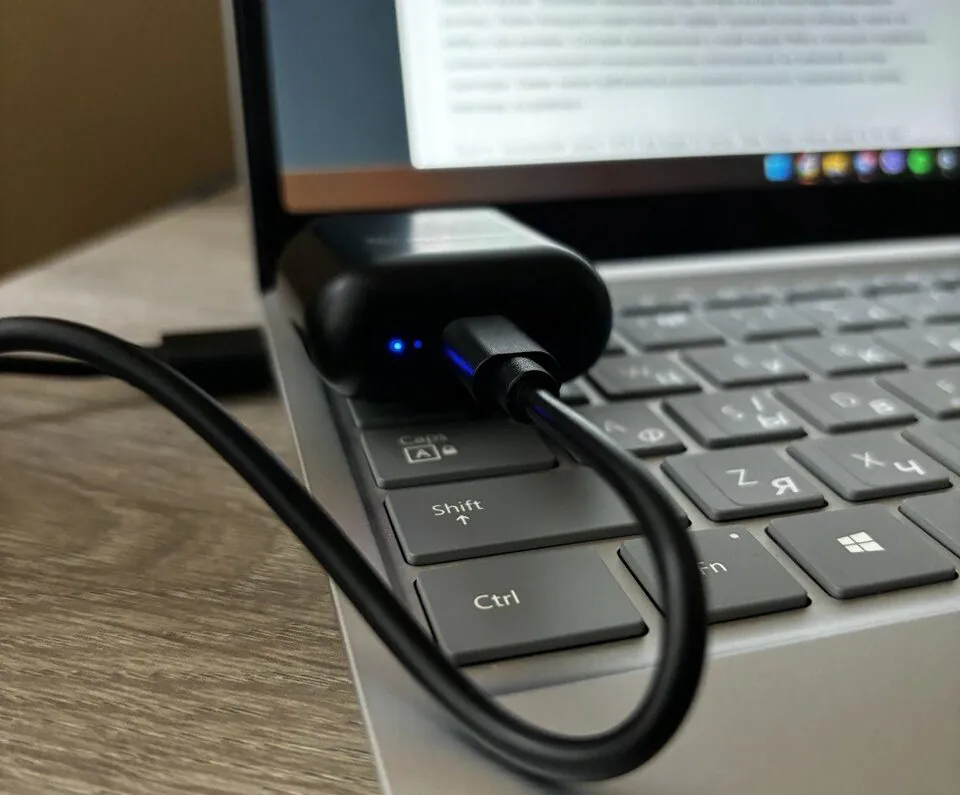
The Moto Buds 120 boast impressive battery life, lasting through an active day of use, and they require no more charging time than other similar earbuds.
Conclusions
First and foremost, the Moto Buds 120 offer compact size and excellent sound quality. Additionally, they boast good battery life, decent passive noise cancellation, and perform well as a headset. Alongside their intriguing design, you can expect comfort in use due to their lightweight and sensitive control sensor, while water and dust resistance ensure prolonged durability. While retrieving the earbuds from the case may not be convenient for everyone, there’s certainly no fear of them falling out unintentionally.
Read alsо:
- ASUS TUF Gaming GeForce RTX 4070 SUPER OC 12GB Video Card Review
- Redmi Note 13 and Note 13 5G Smartphones Review



